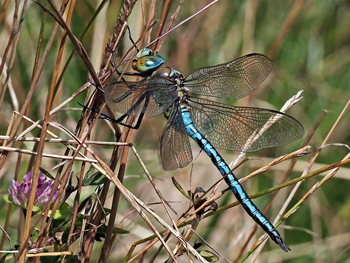insecto-, insect-, insecti- +
(Latin: a bug; literally, "cut into," from insectum, with a notched or divided body; literally, "that which is cut up, segmented" [as the bodies of the first invertebrates to which the term was applied or appeared to be])
2. Spraying aircraft for insects, a procedure called disinsection.
3. Freeing any area from insects.
Some countries in Africa, Latin America, the Caribbean, Australia, and the South Pacific require the spraying of aircraft passenger compartments with insecticide while passengers are present. This is done to prevent the importation of insects; such as, mosquitos.
Disinsection procedures have been determined to be safe by the World Health Organization (WHO); however, they may aggravate allergies for some passengers.
2. Any of numerous usually small arthropod animals of the class Insecta, having an adult stage characterized by three pairs of legs and a body segmented into head, thorax, and abdomen and usually having two pairs of wings. Insects include the flies, crickets, mosquitoes, beetles, butterflies, bees, and dragonflies.

This is an example of an insect known as a dragonfly.
Some are parasitic, others serve as intermediate hosts for parasites, including those that cause many human diseases. Some are wingless; others, such as, the Diptera, have only one pair of wings.
Respiration is by tracheoles, cuticle-lined air tubes that pass air directly to the tissues. Development in higher forms is holometabolous and passes through distinctive egg, larval, pupal, and adult stages.
2. The killing of insects.
An insecticide is a pesticide used to kill insects in all developmental forms. They include ovicides and larvicides used against the eggs and larvae of insects. Insecticides are widely used in agriculture, people's dwellings and workplaces, and even in medicine.
2. Like an insect in shape or form.
2. Having the nature of insects.
3. Consisting of insects.
They are mostly of small size, and their molar teeth have sharp cusps. Most of the species burrow in the earth, and many of those of cold climates hibernate in winter.
The order includes the moles, shrews, hedgehogs, tanrecs (small insectivore, native of Madagascar), and allied animals, also the colugo (arboreal nocturnal mammal of southeast Asia and the Philippines).
![]() An entomological unit of words about insects.
An entomological unit of words about insects.
A cross reference of other word family units that are related directly, or indirectly, with: "insects, bugs, worms; invertebrates": aphidi-; api-; ascari-; culci-; Dung Beetle Survival; Dung Beetles Important; Eating Worms; entomo-; formic-; Guinea worms; helmintho-; Insects: Importance; isopter-; larvi-; lepidopter-; meliss-; mosquito; Mosquito, other Languages; Mosquitoes, Pt. 1; Mosquitoes, Pt. 2; myrmeco-; scarab; scoleco-; sphec-; taeni-; termit-; vermo-.

